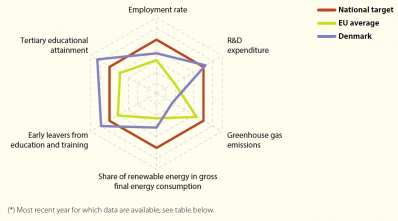Archive:Europe 2020 indicators - Denmark
- Data from December 2014. Most recent data: Further Eurostat information, Main tables.
This article is part of a set of statistical articles based on the Eurostat publication Smarter, greener, more inclusive? - Indicators to support the Europe 2020 strategy. It provides recent statistics on the Europe 2020 strategy of the European Union (EU), focusing on the situation in Denmark.

Main statistical findings

In 2013, Denmark exceeded its national targets on early school leavers and tertiary educational attainment, by 2 and 3.4 percentage points respectively. Denmark was the only EU country to exceed its national R & D target of 3 % of GDP. In 2013, the employment rate in Denmark increased for the first time since the start of the economic crisis, but the distance to the national target was reduced only marginally. In 2012, the country was closer than the EU average to meeting its renewable energies objective but lagged behind in terms of reducing its levels of GHG emissions in non-ETS sectors. The number of people living in households with very low work intensity — used in Denmark as a national target in the area of poverty and social exclusion — increased by 12.5 % from 2012 to 2013, further enlarging the gap to the national target.
Data sources and availability
More information about the origin of the data and the calculation of indicators can be obtained via the Europe 2020 indicators dedicated website.
Under 'Tables', click on the icons next to the indicators:
- 'Explanatory texts (metadata)' for a detailed overview of the collection and compilation methods;
- 'Information on the leaf' for data availability per country.
A more general overview of quality procedures can be found in Implementation of standard reference metadata for indicators - the ESMS Indicator Profile (ESMS-IP) (PDF file).
See also
Further Eurostat information
Publications
- Smarter, greener, more inclusive - indicators to support the Europe 2020 strategy (online publication, also downloadable as PDF file)
Main tables
Dedicated section
Methodology / Metadata
- Towards robust quality management for European Statistics - Communication from the Commission COM(2011) 211 final
Other information
- Regulation 223/2009 of 11 March 2009 on European statistics